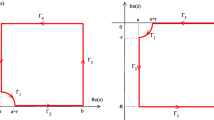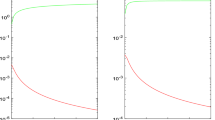Abstract
The integrals of arbitrary products of zero-order and first-order Bessel functions (double Bessel functions) are widely used in practical problems. However, due to the strong oscillation and slow decay properties of the product terms of the double Bessel function, traditional numerical integration algorithms are no longer applicable. It is particularly important to develop high-precision and high-efficiency numerical algorithms for these types of integrals. In this paper, using the large argument approximate expression of the Bessel function and the accumulation property of the integral, double Bessel function integrals are transformed into the algebraic sum of ordinary integral forms in finite region and Fourier transform forms. The folded linear approach method and the Gaver–Stehfest (G–S) inverse Laplace transform method are developed for double Bessel function integrals and double-order single-argument Hankel transforms. Numerical examples are given to verify the efficiency and precision of these methods. The results show that the precision of the folded linear approach method is higher than that of the G–S inverse Laplace transform method, while the latter is more efficient and runs several times faster than the former. These two methods have different requirements for \(F(\lambda )\) when using the double Bessel function integrals. Therefore, the method that should be selected depends on the requirements of the specific \(F(\lambda )\) problem. This paper presents reliable computing methods for the study of fracture mechanics, electromagnetic responses, acoustic wave scattering, and droplet wetting.


























Similar content being viewed by others

References
Anderson WL (1989) A hybrid fast Hankel transform algorithm for electromagnetic modeling. Geophysics 54(2):263–266
Brunner H (2009) On the numerical solution of first-kind Volterra integral equations with highly oscillatory kernels. Isaac Newton Institute. In: HOP 2009: highly oscillatory problems: to applications
Brunner H, Iserles A, Nørsett P (2007) Open problems in the computational solution of Volterra functional equations with highly oscillatory kernel. In: Isaac Newton Institute: HOP 2007: effective computational methods for highly oscillatory solutions
Brunner H, Davies PJ, Duncan DB (2009) Discontinuous Galerkin approximations for Volterra integral equations of the first kind. IMA J Numer Anal 29:856–881
Cao Z, Dobrynin AV (2015) Polymeric droplets on soft surfaces: from Neumann’s triangle to Young’s law. Macromolecules 48(2):443–451
Chave AD (1983) Numerical integration of related Hankel transformations by quadrature and continued fraction expansion. Geophysics 48(12):1671–1686
Chen RY, Xiang SH (2008) A modified method of calculating the sine and cosine transform (in Chinese). Chin J Eng Geophys 5(4):416–419
Filon LNG (1930) III.-On a quadrature formula for trigonometric integrals. Proc R Soc Edinb 49:38–47
Guo SW (2010) Study about 1D forward and inversion algorithm of central loop transient electromagnetic method (in Chinese). Chengdu Univ Technol 2010:5
Hua J, Jiang YS, Wang WB (2001) The numerical integration of dual Hankel transformation (in Chinese). Goalgeol Explor 29(3):58–62
Huybrechs D, Vandewalle S (2006) On the evaluation of highly oscillatory integrals by analytic continuation. SIAM J Numer Anal 44(3):1026–1048
Jain A, Spann A, Cochrane A, Schunk PR, Bonnecaze RT (2017a) Fluid flow in UV nanoimprint lithography with patterned templates. Microelectron Eng 173:62–70
Jain A, Spann A, Bonnecaze RT (2017b) Effect of droplet size, droplet placement, and gas dissolution on throughput and defect rate in UV nanoimprint lithography. J Vacuum Sci Technol B Nanotechnol Microelectron Mater Process Meas Phenom 35(1):011602
Jiang SF, Xiang SH (2007) An efficient method to calculate the sine and cosine transform (in Chinese). Chin J Eng Geophys 4(5):512–515
Johansen HK, Sorensen K (1979) Fast Hankel transforms. Geophys Prospect 27(4):876–901
Kaufman AA, Keller GV (1983) Frequency and transient soundings. Elsevier, Amsterdam
Kiryakova V, Al-Saqabi B (1999) Explicit solutions to hyper-Bessel integral equations of second kind. Comput Math Appl 37:75–86
Knight JH, Raiche AP (1982) Transient electromagnetic calculations using the Gaver-Stehfest inverse Laplace transform method. Geophysics 47(1):47–50
Kuznetsov A (2013) On the convergence of the Gaver–Stehfest algorithm. SIAM J Numer Anal 51(6):2984–2998
Li DZ, Yang ZQ, Liang Z (1996) Numerical computation of Bessel function for complex arguments (in Chinese). J Univ Electron Sci Technol China 25(7):125–128
Li M, He W, Li Q, Xu Z, Luo C (2010) The numerical integration algorithm of dual Bessel function and its application. Int J Appl Electromagnet Mech 33(1–2):727–734
Li JH, Zhu ZQ, Liu SC, Liu XM, Zeng SH, Luo WX (2011) Rectangular loop transient electromagnetic field expressed by Gaver-Stehfest algorithm(in Chinese). Oil Geophys Prospect 46(3):489–492
Li DJ, Weng AH, Yang Y, Li SR, Yang DF (2014) Frequency range discussion of use polygonal line approximations method to calculate the cosine transform (in Chinese). Prog Geophys 29(4):1689–1694
Li FP, Yang HY, Deng JZ, Tang HZ, Liu XH, Zhao HJ (2016) Comparison of several frequency-time transformation methods for TEM forward modeling. Geophys Geochem Explor 40(4):743–749
Loeber JF, Sih GC (1968) Diffraction of antiplane shear waves by a finite crack. J Acoust Soc Am 44(1):90–98
Lucas SK (1995) Evaluating infinite integrals involving products of Bessel functions of arbitrary order. J Comput Appl Math 64(3):269–282
Luo HG (2012) The study about 1D forward modeling of large-fixed loop TEM(in Chinese). China Univ Geosci (beijing) 2012:8
Meng LL (2019) Resolution of loop-source transient electromagnetic method (in Chinese). China Univ Min Technol (beijing) 219:1
Milovanovic GV (1998) Numerical calculation of integrals involving oscillatory and singular kernels and some applications of quadratures. Comput Math Appl 36(8):19–39
Piao HR, Yin CC (1987) Calculation of transient E.M. sounding using the Gaver-Stehfest inverse Laplace transform method (in Chinese). Comput Tech Geophys Geochem Explor 9(4):295–302
Raiche AP (1987) Transient electromagnetic field computations for polygonal loops on layered earth. Geophysics 526:785–793
Shampine LF (2008) Vectorized adaptive quadrature in Matlab. J Comput Appl Math 211:131–140
Shjndo Y (1976) Diffraction of antiplane shear waves by a finite crack in the presence of the magnetic field. ZAMM-Zeitschrift Für Angew Math Und Mech 56(1):33–41
Singh BM, Rokne J, Dhaliwal RS (2011) Diffraction of antiplane shear waves by a finite crack in a piezoelectric material. ZAMM-J Appl Math Mech 91(11):866–874
Tang BS (2008) The study about 1D forward and inversion of central-loop TEM (in Chinese). China Univ Geosci (beijing) 2008:4
Villinger H (1985) Solving cylindrical geothermal problems using Gaver-Stehfest inverse Laplace transform. Geophysics 50(10):1581–1587
Wang HJ (2004) Digital filter algorithm of the sine and cosine transform. Chin J Eng Geophys 1(4):329–333
Wang YD, Yang HH (2012) Numericai calculation method of induced EMF from rectangular loop over layered medium (in Chinese). J Beijing Jiaotong Univ (beijing) 5:62–67
Xiang SH (2012) Efficient methods for some highly oscillatory integrals and integral equations (in Chinese). Sci Sin Math 42(7):651–670
Xiang S, Brunner H (2013) Efficient methods for Volterra integral equations with highly oscillatory Bessel kernels. BIT Numer Math 53(1):241–263
Yang YL, Wang X, Li X (2021a) Effects of droplet on the deformation of elastic gradient thin substrate (in Chinese). Appl Math Mech 42(1):58–70
Yang YL, Li X, Wang WS (2021b) Wettability of semispherical droplets on layered elastic gradient soft substrates. Sci Rep 11(1):2236
Yukihiro Y, Issei T, Kazuki S, Tomoaki K (2021) Wettability model for water-ethanol binary mixture droplet on roughened low-surface-energy solids. Int J Multiphase Flow 137:103569
Zeidler E (2012) Teubner-Taschenbuch der Mathematik. Vieweg+Teubner, London
Acknowledgements
This work was supported by the National Natural Science Foundation of China (Grant nos. 42064004 and 82060331), and the first class discipline construction project in Ningxia Universities: Mathematics.
Author information
Authors and Affiliations
Corresponding authors
Additional information
Communicated by Hui Liang.
Publisher's Note
Springer Nature remains neutral with regard to jurisdictional claims in published maps and institutional affiliations.
Rights and permissions
About this article
Cite this article
Yang, Y., Ding, S., Wang, W. et al. The numerical algorithms of infinite integrals involving products of Bessel functions of arbitrary order. Comp. Appl. Math. 41, 116 (2022). https://doi.org/10.1007/s40314-022-01816-3
Received:
Revised:
Accepted:
Published:
DOI: https://doi.org/10.1007/s40314-022-01816-3
Keywords
- Double Bessel function integrals
- Large argument approximate expression of the Bessel function
- Folded linear approach method
- G–S inverse Laplace transform method



